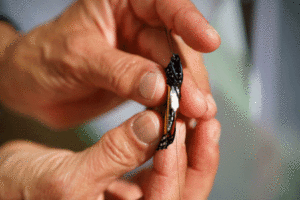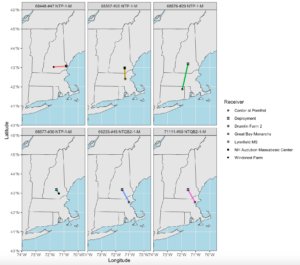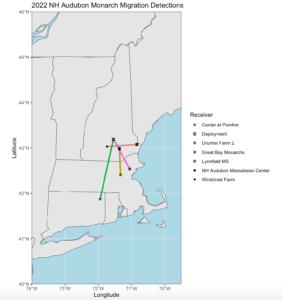
The placement of tiny nanotags on migrating monarch butterflies is part of the larger Motus Project, a global migration tracking system that NH Audubon and many partners are expanding in the Northeast. Nanotags are lightweight radio-transmitters with unique signals that can be detected by Motus receivers placed throughout the landscape. These nanotags will, hopefully, allow biologists to track fall movements of monarch butterflies. The last summer generation of monarchs travel south to overwinter in central Mexico. A journey of close to 3000 miles. Tracking information can help to identify target areas for habitat improvement, such as planting fall-blooming nectar sources to support migrating monarchs.

The monarch is a formerly abundant butterfly species that has experienced dramatic and widespread declines since the early 1990’s. Conservation efforts are underway across the US to understand and take action to stop this decline. Biologists have used adhesive paper tags to study monarch migration since the 1940’s. Tagging in this way has yielded some information about migration routes, but the majority of the tags are recovered at the wintering areas in Mexico. The Motus tracking system, however, makes it possible to determine travel speeds and trajectories during the course of migration. Increased understanding of post-emergence behavior and migration travel of monarchs can help to inform conservation efforts.
In 2022, New Hampshire Audubon placed 58 nanotags on monarchs migrating along the coast and through the Great Bay National Wildlife Refuge and inland through Concord and Manchester.
Where and when our tagged monarchs are picked up by a Motus tower will help to further our learning about monarch migration. Excited to share that to date, six of our tagged monarchs have been picked up by towers as they continued their migration. All tell a story that we can use to inform our knowledge of migration and potential conservation efforts.

Two of our tagged monarchs that were released in Concord, NH were picked up by a tower in Lynnfield, Massachusetts. Interestingly, each of these monarchs were tagged and released on separate days. The monarch carrying Tag #69 was released on September 15 and detected by the Lynnfield tower on September 17. In less than 48 hours this monarch flew ~60 miles. Definitely impressive flight speed. The second monarch carrying Tag #45 was released on September 16 and detected by the tower on September 23. Fascinating to contemplate the difference in flight speeds, potential trajectories, the fact that they were both picked up at the Lynnfield tower. Aerial photos of this area reveal that this tower is in close proximity to the Lynnfield Marsh (Reedy Meadow). Reedy Meadow is the largest freshwater cattail marsh in Massachusetts with over 540 acres of cattails, purple loosestrife, scrub swamp. Although invasive, purple loosestrife is known as a nectaring target for migrating monarchs. Was this the attraction?
A coastal tagged monarch left Great Bay and headed inland to be picked up by a tower in Weare. This is always surprising but has been noted before. The longest flight detected to date is a monarch that left Concord, NH on September 16th and was picked up by a tower in Pomfret, CT on September 17th. This was a journey of 120 miles in 24 hours. Seems extraordinary. Strong Northwest winds prevailed during that flight period and illustrate the important role that wind direction can play as monarchs undertake migration. Thankful that our 2022 tagging is helping to inform flight patterns and potential conservation actions.
